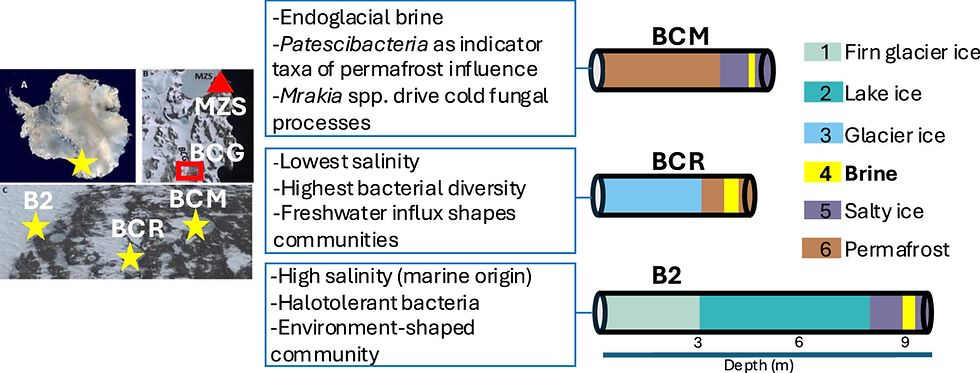Inactivation of mitochondrial pyruvate carrier promotes NLRP3 inflammasome activation and gout
- David Ojcius
- Feb 14, 2023
- 4 min read
The nucleotide-binding and oligomerization domain, leucine-rich repeats, and pyrin domain-containing protein 3 (NLRP3) inflammasome plays a crucial role in innate immunity and is involved in the pathogenesis of autoinflammatory diseases. Glycolysis regulates NLRP3 inflammasome activation in macrophages. However, how lactic acid fermentation and pyruvate oxidation controlled by the mitochondrial pyruvate carrier (MPC) affect NLRP3 inflammasome activation and autoinflammatory disease remains elusive. We found that the inactivation of MPC with genetic depletion or pharmacological inhibitors, MSDC-0160 or pioglitazone, increased NLRP3 inflammasome activation and IL-1β secretion in macrophages. Glycolytic reprogramming induced by MPC inhibition skewed mitochondrial ATP-associated oxygen consumption into cytosolic lactate production, which enhanced NLRP3 inflammasome activation in response to monosodium urate (MSU) crystals. As pioglitazone is an insulin sens MSDC-itizer used for diabetes, its MPC inhibitory effect in diabetic individuals was investigated. The results showed that MPC inhibition exacerbated MSU-induced peritonitis in diabetic mice and increased the risk of gout in patients with diabetes. Altogether, we found that glycolysis controlled by MPC regulated NLRP3 inflammasome activation and gout development. Accordingly, prescriptions for medications targeting MPC should consider the increased risk of NLRP3-related autoinflammatory diseases.
By. Lih-Chyang Chen, Yu-Jen Chen, Hsin-An Lin, Wu-Chien Chien, Kuen-Jou Tsai, Chi-Hsiang Chung, Jui-Yang Wang, Chien-Chou Chen, Nan-Shih Liao, Chieh-Tien Shih, Yi-Ying Lin, Chi-Ning Huang, David M. Ojcius, Kuo-Yang Huang, Hsin-Chung Lin
INTRODUCTION
The NOD, LRR, and pyrin domain-containing protein 3 (NLRP3) is an intracellular sensor that detects a range of microbial molecules, endogenous danger signals, and environmental stimuli, and their stimulation leads to the formation of the NLRP3 inflammasome complex [1]. The assembly of the NLRP3 inflammasome is initiated by oligomerization of NLRP3, which recruits apoptosis-associated speck-like protein containing a CARD (ASC) to activate cysteine-aspartic acid protease-1 (caspase-1), which consequently mediates the cleavage of pro-interleukin 1 beta (pro-IL-1β) to the mature proinflammatory cytokine IL-1β. Increasing evidence suggests that improper NLRP3 inflammasome activation is responsible for the pathogenesis of autoinflammatory diseases, including gout, type 2 diabetes mellitus (T2DM), atherosclerosis, and Muckle–Wells syndrome [2]. For example, gout is caused by monosodium urate (MSU) crystal-induced NLRP3 inflammasome activation in macrophages [3].
Glycolysis regulates NLRP3 inflammasome activation [4, 5]. In response to NLRP3 activators, hexokinase-dependent production of mitochondrial reactive oxygen species (ROS) is required for NLRP3-dependent caspase-1 activation [4, 6]. In addition, hexokinase regulates lactate production, which promotes eukaryotic translation initiation factor 2-alpha kinase 2 (EIF2AK2) phosphorylation [5]. Pharmacological and genetic inhibition of EIF2AK2 attenuates NLRP3 inflammasome activation and consequently suppresses the release of IL-1β [5, 7]. These results suggested that both lactic acid fermentation and pyruvate oxidation are involved in NLRP3 inflammasome activation. In glycolysis, one glucose molecule is converted to pyruvate and produces two ATP molecules. Pyruvate is imported into mitochondria by the mitochondrial MPC, which is a heterodimer composed of MPC1 and MPC2 proteins. In the mitochondria, cells produce more ATP by oxidative phosphorylation (OXPHOS) [8]. Alternatively, pyruvate can be converted to lactate under certain conditions [9]. The inactivation of MPC inhibits mitochondrial pyruvate uptake and switches the dependence of the cell on glycolytic ATP production [10-12]. Although MPC has been shown to be a glycolytic switch between lactic acid fermentation and pyruvate oxidation, its role in NLRP3 inflammasome activation and autoinflammatory diseases remains elusive.
The incidence of DM in Taiwan increased by 70% in the early 21st century, which is consistent with a 35% increase in the global diabetic population [13]. DM is a worldwide epidemic, with a projected global diabetic population of 552 million individuals by 2030 [14]. DM shares a complex comorbid relationship with gout, which is a treatable form of inflammatory arthritis. The prevalence of gout is higher in patients with T2DM than in those with type 1 DM (T1DM); the prevalence of gout is highest (41%) in male patients with T2DM over 65 years [15]. An epidemiological study reported that gout was present in 6.24% of the Taiwanese population [16]. Furthermore, a Taiwanese cohort study found that among approximately 4000 patients with gout, 13.24% developed T2DM during the follow-up period, suggesting that gout may be an independent risk factor for T2DM [17]. In addition to the relationship between gout and DM, gout in Taiwan has been reported to be associated with comorbidities, such as hypertension, renal insufficiency, heart failure, and myocardial infarction [18]. Hence, gout is an important public health concern, and its relationship with T2DM requires further exploration.
The most common first-line glucose-lowering medication used worldwide is metformin, and second-line oral antihyperglycemic medications target underlying insulin resistance [19-22]. Pioglitazone, a member of the thiazolidinedione class of drugs, is a common insulin-sensitizing peroxisome proliferator-activated receptor-gamma (PPAR-γ) agonist used as monotherapy or in combination with metformin or insulin [19, 21]. Clinical trials of pioglitazone administered to patients with T2DM as monotherapy or in combination with metformin, insulin, or sulfonylureas demonstrated that glycaemic control and lipid profiles improved significantly in both short- and long term [23]. Moreover, emerging evidence shows a new function of pioglitazone in MPC inhibition by directly binding to MPC1 and MPC2 proteins [24]. The effect of pioglitazone on MPC inhibition remains largely unknown.
Glycolysis is important for activating the NLRP3 inflammasome [4, 5], which is involved in autoinflammatory diseases [2]. Although MPC is known to be a glycolytic switch in lactic acid fermentation and OXPHOS [10-12], its role in NLRP3 inflammasome activation and autoinflammatory diseases is unclear. By employing pharmacological and genetic inhibition of MPC, we report that glycolytic reprogramming induced by MPC inhibition skewed OXPHOS into lactic acid fermentation, which enhanced NLRP3 inflammasome activation. Moreover, inhibition of MPC by pioglitazone, an insulin sensitizer used for diabetes, promoted MSU-induced peritonitis in diabetic mice and increased the risk of gout in diabetic patients.
Read more at:
https://onlinelibrary.wiley.com/doi/10.1111/imm.13628








Comments